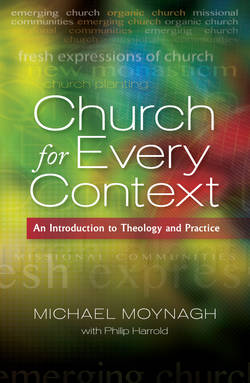Читать книгу Church for Every Context - Michael Moynagh - Страница 15
На сайте Литреса книга снята с продажи.
Some examples
ОглавлениеNew contextual churches can be classified in a variety of ways. One is to describe them in relation to the local church. On this basis, some are closely linked to an existing church. They emerge from within a ‘fringe’ group – a mission venture or a community project, for instance – so that these initiatives are no longer stepping stones to Sunday church but become ‘church’ in their own right.
For example, the leaders of a church-run luncheon club for older people invited members to stay behind after the meal for quarter of an hour, at the start of which a candle was lit on each table. There followed some Christian music, a reading from Scripture, a period of silence and some prayers. This became the start of a journey to faith for those involved, and the beginning of a church alongside and in the context of the luncheon club.
Alternatively, a local church may bring a Christian community to birth as part of a new initiative. A Sunday ‘Drop In’ opened in inner-city Bristol in 2010 to serve a marginalized section of society. There is a cup of tea, some food, pool and table tennis, newspapers and a prayer board. Toward the end of the session, someone invites requests for prayer and a short, informal prayer time follows. Numbers vary from 15 to 25 each week. Some have asked to be baptized. There is cross-fertilization with the regular Sunday congregation. Some of the latter help run Drop In, while a few from Drop In attend church groups or occasional services.
The leaders see Drop In as
an experiment in a new way of being church, at a time when regular church has lost its draw. We do not know where it is leading, or whether it will last . . . We think that we have created something – small and fragile, certainly – where healing and transformation can take place, and a new kind of community can grow.5
New contextual churches have emerged within networks that jump localchurch boundaries – in a Methodist circuit, an Anglican deanery or among local churches from different denominations acting together. A number of youth congregations have been started through this type of collaboration, such as Eden, a monthly youth gathering in Sussex that breaks into separate youth groups on the other Sundays (Lings, 2007). The congregation is connected to a group of churches in an area rather than to one local church.
Potentially important is a further category. These are gatherings beyond the reach of the local church. They are started by individuals in the context of their daily lives – in a school, among friends or perhaps at work. The initiative comes not from an existing church or group of churches, but from an individual or group who may or may not be recognized by the wider body. A group of women started a monthly event in a leisure centre, for example. Visiting speakers talked about how God had helped them to lead ‘fit lives’, such as when bringing up a child with handicaps or when facing a crisis. The leaders recognized that when individuals began to enquire about Jesus, this would have the potential to become a church.
